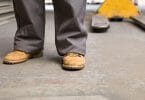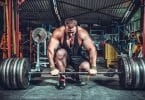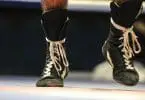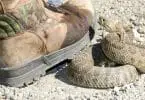We’ve updated our list and reviews, to make sure you’re equipped with everything you need for success in the coming year! Being a chef is no easy task. The workload involved is draining, the fast-paced environment rarely stops or slows, and the hours are long and tiresome. Spending the entire day or night on your feet can become burdensome quickly. For this reason and many others, it’s vital to wear the best chef shoes for comfort and support when spending this much time on your feet.
It’s a common saying to spend heartily on items that separate your body from the ground: tires, mattresses, and shoes. This guide is a complete handbook for finding the best shoes for current and budding chefs. The list we have cultivated contains the strongest chef shoes on the market, based on plenty of testing and research.
Why Are Shoes So Important For Chefs?
When working in a fast-paced kitchen environment, chefs face many hazards regularly. Many kitchen tools pose a danger to life and limb. If they fall or malfunction, they can easily cause serious damage to a chef’s legs and feet. It doesn’t take much at all for a serious accident to occur.
Spills also pose a substantial threat. Not only can hot liquids lead to serious burns on the feet but slip and fall accidents are rampant in the food industry, sometimes leading to serious injury. It is the responsibility of the staff and the chef to ensure safety regulations are followed. However, even the safest of workspaces is not free from accidents
Common Mistakes of Buying Chef Shoes
Chef shoes are some of the most important equipment a chef can buy. However, they are rarely treated as such. Different guidelines should be considered when researching and comparing chef shoes!
Chefs tend to make persistent mistakes when buying shoes for their work. These mistakes are far more likely to occur if buying a pair of chef shoes is treated like a standard purchase, like a pair of pants that will likely be dirty in a week, or a bandana to wipe the consistent beads of sweat. But this isn’t the case!
Need an example? When it comes to footwear in the kitchen, function, and comfort are far more important than aesthetics. If the shoe can deliver on functionality and remain comfortable, while remaining visually appealing, that is wonderful. However, practicality and functionality should be at the forefront. Consider these features when deciding which shoes are the best for you!
Consider Workplace Hazards
Not all shoes are created equal! Before starting your shoe shopping, consider any workplace hazards you commonly encounter. One of the biggest for kitchen staff is spills and slippery surfaces, meaning any shoes you buy should have slip-resistant outsoles. Protection from falling objects or hot liquids might also be a concern. Check for those features in any potential shoes so you know you’ll be safe at work!
Size and Fit
The size and fit of your shoes make the difference not only in comfort but also in safety! Tight shoes will pinch your feet, while loose shoes won’t provide cushioning and support in the right places. Additionally, shoes that are too loose increase your risk of slipping and tripping.
Comfort and Function Before Style
At the end of the day, all that matters is that your shoes fulfill the function they’re meant to. They should keep you safe from workplace hazards while also reducing strain and fatigue. While it might be tempting to buy the shoes that look the best, remember that your feet will thank you when you invest in functionality and comfort first!
Comparing Quality and Price
High-quality chef shoes are not something that comes cheap. A chef might have second thoughts about spending a good bit of money on a work shoe that will get dirty and covered in food almost immediately. However, is your safety, security, and comfort in the workplace the best place to try and save money?
Cost doesn’t necessarily correlate to higher durability and functionality. Many chefs and cooks will fall into the trap of purchasing inexpensive ten-dollar slip-on shoes from big box retail establishments. The slip-resistance of a ten-dollar shoe will pale in comparison to its fifty-dollar alternative.
Best Chef Shoes for 2023
Through extensive research and testing, both online and in person, we’ve selected these shoes as the ideal blend of comfort, functionality, aesthetic, and price. These are the best shoes on the market in 2023, vetted by professionals with years in the industry.
Many of our recommendations are from Dansko, Birkenstock, and Skechers. This is because, by and large, we’ve found these to be the shoes best suited for work in the kitchen on the points that matter: safety and comfort. These brands offer a wide range of shoe options and are the primary choice of chefs and kitchen staff again and again!
- Best All-Around— Birkenstock Professional Slip Resistant Work Shoe (aka, Profi-Birki)
- Best for Professionals (Runner-Up Overall)— Dansko XP 2.0 Men’s | Women’s
- Best for Looking Good— Birkenstock Boston Super-Grip
- Best for Kitchen Safety — Birkenstock A 640 Steel Toe
- Best Sneaker Style Kitchen Shoe— New Balance 412 Alloy Toe Men’s | Women’s
- Honorable Mention— Crocs On The Clock Work Slip-On
- Honorable Mention—Skechers Balder Slip Resistant Work Clog
Best Chef Shoes of 2022 – Evergreen List
These are the shoes that withstood the test of time; just as great in the new year as the one before!
- Best for Traditionalists— Dansko Professional Clogs Men’s | Women’s
- Best on a Budget— Crocs Bistro Clog & Crocs Graphic Bistro Clog
- Best for Keeping Cool— Skechers Flex Advantage McAllen Slip-On
Finding the Right Shoe for the Job
The shoes above provide the most effective blend of utility, longevity, comfort, and price.
A chef needs to make sure to take every aspect and nuance of their job into account when selecting the ideal pair of work shoes for their specific needs. What kind of kitchen will you be working at? What are the specifics of the work being performed? What types of ingredients are you working with?
Chefs and cooks have an impressive array of different responsibilities. These responsibilities depend on their skill level and the volume that is pushed through the kitchen.
Detailed Reviews: Finding the Best Chef Shoes
The world of chef shoes is complicated and expansive. You’d think that a box full of black shoes would be simple. You’d be wrong. Chefs need to ensure they have the right information to make an informed decision that meets their needs.
Chefs are on their feet well over 40 hours a week. A pair of high-quality shoes is a must. Anything else over extended time frames will lead to potentially permanent damage down the road.
Let’s dive into each of the shoes listed above and see which needs they meet for the melting pot of chefs and cooks.
Best All-Around Chef Shoes—Birkenstock Professional Slip-Resistant Work Shoe (aka, Profi-Birki)
Available at:
If you are on the hunt for a shoe that will last for multiple years of continuous use as a chef, look no further than the Birkenstock Professional Slip Resistant Work Shoe. Multiple features of this shoe truly make the price worth it.
Birkenstock offers some of the highest quality shoes on the market currently. This goes for not only their standard footwear offerings but also their work shoes and chef shoes. While the Birkenstock Professional series is over double the price of the similar Skechers alternative, there is a good reason. Every shoe serves a purpose, and these shoes are top-of-the-line in their respective purpose.
The soles can be replaced, which means that after extended use, they can easily be swapped out for new ones. This speaks wonders to the estimated longevity of the uppers, putting them in the same quality category as several-hundred-dollar dress shoes from brands such as Allen Edmonds. This also assists in maintaining the longevity of the shoe.
Our favorite thing about these shoes is their toughness and indestructibility. They can be placed in the dishwasher at the end of each shift for a good scrub. This is an incredibly unique feature, and chefs can wash these shoes without being concerned about wear and tear. However, it’s important to remember that Birkenstocks tend to run large, typically fitting a size above your typical shoe size.
For more details read our complete review of the Birkenstock Professional Profi Birki Slip Resistant Work Shoe.
Best Chef Shoes for Professionals—Dansko XP 2.0
Available at:
The two primary concerns a chef shoe must address are safety and comfort. To maximize safety, Dansko upgraded the outsole on the XP 2.0 from the original Dansko Professional with research and testing from SATRA to make sure these shoes wouldn’t slip in the conditions you’re likely to encounter in the kitchen: oily floors, greasy floors, and wet and slick floors.
The other big improvement Dansko made when designing the XP 2.0 was implementing a removable memory foam footbed. The lack of a removable footbed was a deal breaker for a lot of people when they considered the Dansko Professional. If you need custom orthotics the XP 2.0 has you covered.
Finally, the XP 2.0 is made with the same high-quality construction techniques as the original Professional model. That means the upper is hand-stapled to the outsole to ensure the shoe isn’t going to come apart on you. The XP 2.0 also has an inner frame made of thermoplastic so the shoe won’t deform on you over time (especially important if they are going to withstand the wet conditions of a kitchen).
For more details read our complete review of the Dansko XP 2.0.
Best Chef Shoes for Looking Good— Birkenstock Boston Super-Grip
Available at:
The Birkenstock Boston Super Grips are some of the best shoes on the market for extensive work in a kitchen environment. They are available in both white and black color options. This is ideal for the constant workplace uniform changes.
While there are less expensive brands and styles of chef shoes with similar shapes for challenge-to-fit feet, they are often made from plastic-based materials and are therefore far less breathable. In comparison, these Birkenstock options are made from high-quality, naturally breathable leather. This leather upper allows chefs and cooks from all walks of life to work full shifts without issues arising from sweat-soaking their socks.
As is standard with the Birkenstock brand, the natural materials utilized for these shoes (cork and leather) take some time to break in. However, once broken in, these could very well be the most comfortable pair of shoes you’ve ever owned.
Additionally, the Super Grip section of the Birkenstock Boston Super Grip Leather Work Shoe is a high-quality non-skid sole, keeping chefs from slip and fall injuries that are far too common in fast-paced kitchen environments. As far as chef shoes go, these are worth every penny.
For more details, read our complete review of the Birkenstock Boston Super Grip.
Best Kitchen Safety Shoes— Birkenstock A 640 Steel Toe
Available at:
A basic clog design with plenty to offer, the Birkenstock A 640 is our pick for the best kitchen safety shoes. Your feet are protected not only from fatigue and slips but also from any sharp or heavy falling objects, as well.
What sets these shoes apart from other Birkenstocks is the solid steel toe cap. It offers protection from up to 200 joules of impact, meaning it can withstand up to 20kg of weight dropped from 1 meter. Whether you’re accepting heavy deliveries or just trying to avoid stubbed toes on sharp corners, a steel toe cap is a great addition to an already fantastic chef’s shoe. For professionals who are on their feet all day, foot injuries are something to avoid.
In addition to the steel toe cap, the A 640 Clogs have a non-slip sole and are made with oil- and grease-resistant material to prevent accidents. They’re also water-resistant and have a removable cork-latex footbed, making them easy to clean, as well. (Water temps up to 175F/80C are safe.)
Comfort-wise, everyone’s feet are individual, so don’t skimp specialized orthotic inserts if you need them. That said, the A 640 footbed is anatomically shaped for the protection of your tendons and joints. The footbed can also be removed and replaced if needed, increasing the longevity potential of them, too.
Best Sneaker-Style Kitchen Shoe— New Balance 412 Alloy Toe Sneaker
Available at:
If clogs aren’t your style, our choices so far may not be to your test. However, there are great sneaker options for those who prefer a more athletic approach to their footwear. That’s why we’ve chosen the New Balance 412 Alloy Toe sneaker as the best to wear in the kitchen.
First things first, alloy toes are as strong as steel. The New Balance 412 meets safety ratings ASTM F2412-11 and ASTM F2413-11 I/75 and C/75. In layman’s terms, its alloy toe will protect your feet from up to 50lbs dropped from 1.5 feet, and compressive loads up to 2500lbs.
While we don’t expect you to see that kind of footwear abuse in the kitchen, rest assured that if your feet do find themselves on the wrong end of something heavy, they’ll be safe. Alloy toes are also 30-50% more lightweight than steel, allowing for easier movement and less weight to cause foot fatigue.
Other great features of this shoe include the leather/mesh upper, great for wicking away the day’s sweat, and a slip-resistant outsole for protection against spills (ASTM F2913-11), as well.
The shoes have an EVA foam footbed for extra cushioning and a padded collar for additional comfort. And if the footbed doesn’t fit your feet, you can swap it out for custom orthotic inserts that are better suited to your needs. Remember, it’s best to be proactive in keeping your feet cushioned and supported rather than on the wrong end of foot conditions like plantar fasciitis.
Best Chef Shoes for Traditionalists— Dansko Professional Clogs
Available at:
The Dansko Professional is one of the most distinctive (opinions differ on whether this is a good distinctive or bad distinctive) chef shoes available, and maintains an intensely loyal following amongst chefs around the world.
One of the reasons that the Dansko Professional has such a strong following is that they are incredibly comfortable if you are on your feet all day. They are built with a rocker bottom that helps you move around while minimizing pronation and providing lateral support. This leaves your feet and calves less tired, leading to fewer injuries and less pain after a long shift.
The other feature that sets Dansko apart is the way you walk in them. By design, your heel should move up and down as you walk in Dansko clogs. This takes a bit of getting used to but is comfortable once you catch on.
The major downside people find is that if you have larger feet, the padded instep across the bridge of the foot can be tight. The padding is there to help alleviate this, but isn’t sufficient for some people.
For more details read our complete review of the Dansko Professional.
Best Chef Shoes on a Budget— Crocs Bistro Clog & Crocs Bistro Graphic Clog
Available at:
Indeed, Crocs aren’t everyone’s favorite due to their appearance. However, the comfort and utility are almost unmatched, especially at the price point. For all this abuse and negativity, the shoes have not suffered from sales, with everybody from Prince George to Michelle Obama having been photographed wearing Crocs.
So why pick them for kitchen work? To begin with, these shoes are practical, quick and easy to slip on, and borderline indestructible. The likelihood for chefs is that investing in a pair of these shoes will lead to a lack of worry for a good bit of time.
The Crocs Bistro Clog has a sturdy, non-slip Crocs Lock tread. There is also a heel strap, providing solid room for the ankles to breathe, and alleviating the persistent heel blisters all too common with most inexpensive, lower-quality chef shoes currently on the market.
The one downside we’ve found with Crocs is that they can lack the necessary arch support for some wearers. Arch support prevents foot fatigue and worse conditions down the road, like plantar fasciitis. So, if you’re looking for arch support, try the Crocs on the Clock option on our list, instead!
For more details read our complete review of the Crocs Bistro Clog.
Best For Keeping Cool— Skechers Flex Advantage McAllen Slip-On
Available at:
The Skechers Flex Advantage McAllen Slip-on looks quite a bit different than the rest of the chef shoes on our list of the Best Chef Shoes. This footwear is mesh fabric compared to solid around the toe. However, the question lingering in the air is a good one: What happens when I drop a pan or knife on my foot?
Compared to alternatives on our list, these shoes are not going to provide the best possible protection around the toe. For this reason, they might not be the strongest choice if you are permanently located in the back of the house, grinding away in the kitchen. However, if you spend a lot of time running around a restaurant and aren’t firmly planted with a knife in your hand, these are a great option.
The main reason we included them in our list is because they contain an extremely comfortable memory foam insole. This makes them by far the most comfortable option we reviewed, and are a great choice if you have solid knife skills and have a far lower risk of dropping knives or heavy pieces of equipment on your feet.
For more details read our complete review of the Skechers Flex Advantage Mcallen Slip-On.
Honorable Mention Chef Shoes
1. Crocs On The Clock Work Slip-On
Available at:
Crocs is one of the industry leaders in work-related shoes, renowned for their simplicity, single-piece design, and comfort levels. They are also one of the most budget-friendly pieces of footwear for chefs. These shoes come with an impressive range of additional features, as well.
The Crocs option has a Sure Grip outsole, preventing slips and falls that are ever too common in the kitchen. Also, the footbed has massaging nodes, to massage the feet with every step while you zip back and forth in the kitchen, while simultaneously stimulating circulation to the lower extremities.
Additionally, this footwear option for chefs has enhanced arch support, assisting in preventing aches and pains from occurring in the center of your foot. These are most common after extended periods of standing, such as after a long shift in the kitchen with minimal time to sit and rest.
For more details read our complete review of the Crocs On the Clock Work Slip-On.
2. Skechers Balder Slip-Resistant Work Clog
Available at:
The wide-fitting clogs from the well-known footwear brand Skechers have been built with comfort in mind as the highest priority. However, these shoes will need to be worn a few times to be fully broken in, so they might be uncomfortable straight out of the box.
They are some of the least expensive shoes on our list and do not skimp on quality and usefulness. Besides the garbage unbranded knock-offs that can be bought from big-box retailers online and in person, these are some of the least-expensive high-caliber chef shoes on the market.
While they might not impress in the longevity department compared to alternatives on Shoe Guide’s list, they are well worth it for the price point. An investment in the Skechers Balder Slip Resistant Work Clog should last about a year of continuous heavy utilization by constantly moving chefs.
For more details read our complete review of the Skechers Slip-Resistant Work Clogs.
Diving Into the Importance of Chef Shoes
High-quality chef shoes, like the options reviewed above, allow cooks and chefs to perform their work at high levels of efficiency, while simultaneously ensuring safety and comfort. Additionally, chef shoes need to have some form of practicality. They need to be comfortable, resistant to spills, slip-resistant, and sturdy to a point where they can protect the feet from heat and falling objects.
These aspects are all vital to the safety, security, and efficiency of the chef. They need to be covered and included in a pair of good-quality chef shoes. But there is another, obvious factor in play as to why a pair of chef shoes is crucial.
Wearing chef shoes in the workplace is often mandatory, and a requirement for most health and safety standards, especially those set forth by OSHA for food service establishments. In these cases, it is almost always the responsibility of the employer to enforce the rules, however, it is the responsibility of the chef to purchase and maintain their footwear.
While comfort and functionality are extremely important, work standards and regulations for safety in the workplace are equally crucial roles and should be considered as well when making purchase decisions for chef shoes. To ensure the safe, productive, uninterrupted operations of a restaurant, it is vital to comply with these safety regulations.
Why Is This So Vital?
Compliance with safety regulations is what cultivates a safe and secure work environment. This is a positive for everyone involved in the process, from the chefs to the waiters. Establishing work safety standards allows employees to carry out daily activities in a safe manner.
If relevant authorities and inspections uncover any deficiencies or discrepancies in the safety of a restaurant during a check, penalties can become substantial. With proper assessment of risk and compliance with regulations, restaurant owners can avoid these problems. This avoidance drastically reduces the chances of workplace accidents, and proper footwear is one of the main points of concern.
Finally, another step of the risk assessment process includes the identification of workplace hazards. This encompasses potential issues regarding safety gear, such as chef shoes. If a cook does not wear a regulated pair of chef shoes, they can expose the establishment to legal disputes, while simultaneously endangering their safety and the safety of others.
Regulations of Labor Safety
Shoes designed to enhance workplace safety, including those made specifically with chefs in mind, are often provided by the workplace. They are responsible for determining the rules workers must follow regarding footwear. They are also responsible for what types of extra protection these chef shoes need to have.
When making a footwear purchase, chefs need to select products that meet the standards of safety set forth by their workplace. For this reason, when switching jobs or restaurants, it’s important to pay attention to their specific requirements for workplace footwear. Some places are far more stringent than others.
Looking from the Point of View of the Chef
There is more to the concept of workplace safety in the kitchen than simple regulatory aspects. There are other reasons why chef shoes are incredibly important. This feature allows chefs to perform their workplace duties at a very high level. Any professional, from a cook to a plumber to a teacher and beyond, can only provide their best work if there are no distractions.
It’s about far more than just comfort, as we have stated throughout this guide. It’s also about practicality, style, and functionality. While style might not be the most important trait to look for in a chef’s shoe, if it’s something that can be discerned, why not do so?
Guidelines for Researching and Purchasing Chef Shoes
There are three main criteria that these selected chef shoes are required to meet for us at Shoe Guide to consider them adequate: Practicality, functionality, and design. Let’s dive into each of these in detail to tease out the specifics that are considered when deciding on the best chef shoes.
Criterion 1: Practicality
Practicality is inclusive of many other sub-factors, including ergonomics, comfort, and design. Regarding ergonomics, selecting a chef shoe with ideal ergonomic qualities is very important, and for more reasons than simple comfort and safety. The proper shoe selection provides ergonomic support for the unique wearer, based on their specific needs and the biological characteristics of their feet.
Ergonomics
A shoe capable of supporting the owner in an ergonomic sense provides tremendous ergonomic advantages over one that does not. As chefs often are required to stand and walk for shifts longer than standard office workers (easily tipping 12 straight hours most days, with minimal breaks) their feet should be supported in every way imaginable.
If a chef shoe is ergonomically sound, it will meet many even deeper needs, including:
- Manufactured from high-quality materials
- Provisions of ample arch support for those suffering from flat feet
- Allowing the feet and legs to function in a structurally sound way
Shoes that fit too snugly, or cannot provide the arch support needed, can be disastrous for long-term health, and lead to extensive problems over time. The proper shoe helps cooks and chefs prevent injuries to the ligaments, and alleviate some of the more common, short-term problems like calluses.
While wearing inadequate shoes might not seem like a problem in the short term, it can wreak havoc on the lower extremities and back over time. If a shoe is ergonomically friendly, it allows the feet and legs to exhibit proper blood flow, while reducing bodily wear and tear. This goes double for the bones, joints, muscles, and ligaments of the legs. Your bones are connected, and bone-related issues can radiate upwards and affect the entire body.
Comfort
Comfort is incredibly important for work shoe practicality. Unless your working hours are minimal, chefs can spend anything from eight to 12, to 14 or more hours at their place of work in a single shift. Most of that time is spent on their feet, either standing or moving around. In uncomfortable shoes, chefs might get distracted, leading to mistakes. Mistakes in kitchen environments never have positive outcomes.
Orthopedic shoes might be the exception to this, though. They don’t often feel comfortable to the wearer. However, this discomfort has its own purpose: correcting bad posture and additional non-degenerative issues. Shoes that are correctly sized and manufactured from high-quality materials are usually more comfortable. However, again, there are exceptions. If possible, chefs should try the shoes on before they buy, or at least purchase from a place such as Amazon that allows returns.
Design
Whether a chef purchases a slip-on (like all the options we tested and suggested as the best) or lace-up work shoe, it is vital to select footwear that is appropriate for the work environment in which they will be worn. If the kitchen back of the house area tends to heat up regularly, breathable shoes are the best design type. Slip-ons are typically superior for chefs, as our own research and testing showed. However, some cooks just simply prefer the snugness and support that lace-up shoes provide.
The other important aspect of design is the weight of the shoe. Shoes need to be more than simply comfortable and flexible. Ideally, they should not be too heavy or bulky. Wear and tear tends to set in far faster if the shoes are heavier in weight. Any chef shoe should provide fast, easy movements around the busy kitchen.
Criterion 2: Functionality
Functionality is inclusive of several other sub-factors, including material, breathability, water-resistance, grip, and ability to be cleaned.
Material
The material of the shoe is extremely important. Essentially, a chef would be on the lookout for a flexible design with durable upper, as they experience consistent standing and movement. Moving back and forth constantly in a hot kitchen environment can put extreme wear and tear on chef shoes.
If these shoes cannot withstand the daily pressures that a chef goes through, there is a chance that deterioration of the upper and sole could begin to occur within a few weeks of the purchase. The proper materials can take a beating and remain in great shape for years before the material begins to decline. Look at some of the options above. We’ve listed options from shoes that can be tossed in the dishwasher, to shoes that have the option to replace the soles, meaning the upper is borderline bulletproof.
Breathability
The aspect of breathability can truly make or break any chef shoe, and have a major effect on the satisfaction with a purchase. In a hot kitchen environment, sweat is a serious commonality. While that may seem gross, it’s just all part of the process, and typically cannot be helped.
Moisture needs to evaporate. If moisture does not have access to evaporation, shoes will quickly become uncomfortable. Even more concerning than discomfort, humid environments, like those inside sweaty socks and shoes, are breeding grounds for bacterial growth.
Footwear that is made from higher quality, breathable materials eliminates this issue through allowance of the feet to breathe. Additionally, enhanced breathability assists to wick moisture and sweat from the shoes, while still protecting the feet. Breathability is an incredibly underrated aspect of high-quality chef shoes, and is something that should be considered heavily when performing due diligence and finding the best chef shoes.
Water Resistance
Wearing water resistant (or sometimes waterproof shoes) in the kitchen is an important thing. At the very least, the upper sole of the shoe needs to be able to withstand significant moisture for safety reasons. In a bustling kitchen, chefs are always near hot oil and boiling water. This makes the potential for catastrophic spilling accidents an ever-looming danger.
These accidents should be avoided at all costs. However, sooner or later, even the most adept chefs are going to find themselves in a situation where the possibility of spills is inevitable. The environment is just so fast-paced and unpredictable.
With low-quality shoes, hot cooling oils, molten animal fats, and boiling water can easily maneuver its way inside of the shoe, and cause serious damage to the feet. Purchasing a pair of water-resistant or waterproof shoes alleviates this danger.
Grip
One of the most common mishaps that occurs in a kitchen environment is a slip and fall accident. While these are sometimes unavoidable (see above, and how spills are a given in such a fast-paced setting), many times they result from ignored or loosely defined safety regulations.
Chefs should always have on anti-slip footwear offering great grip. This way, even when spills occur, they can stay on their feet and handle the situation appropriately. This is why all our suggested chef shoes have strong grip.
Cleanability
The highest quality chef shoes for the kitchen are quick and simple to clean. When under constant use, the bustling kitchen environment will cause buildup on footwear in no time. It doesn’t matter if a chef starts with a brand-new pair of shoes. By the end of a long shift, they will be dirty and covered with spills and spatters.
Most chef shoes require daily care, whether that be throwing them in a dishwasher, giving them a rinse with a hose, or just wiping them off with a cloth. For this reason, they should be quick and easy to clean.
Criterion 3: Style
While style in general commands less of a dire need in the kitchen than practicality and functionality, it is inevitable that style will play a role in the purchase of a pair of chef shoes. There are two main style types that comprise all chef shoes currently on the market: slip-on and laces.
Slip-ons are often far more ideal for chefs, and comprise all the options we have suggested to chefs for shoes. This is because they are far easier to put on and take off. The lack of lacing also means that there is little chance for them to come loose and cause slip and fall hazards.
Another factor for slip-on shoes is food safety. When chefs need to stop and tie their shoes, they must wash their hands afterwards. If a chef’s shoes are ill-fitting and lacing is consistently coming undone or loosening, this can be a substantial inconvenience and time waste. This can be problematic in a setting where timing is everything.
With slip-on chef shoes, cooks can easily avoid the above problems. However, it is vital to select a model that can hold the heels firmly. Crocs are a popular brand for this, and while chef shoes with heel straps are safe, they might lack in the comfort department.
Shoes with lacing are fine, until the need arises to ensure coverage. Are the shoes water resistant? Do they have strong uppers? While lace-up shoes are notoriously more breathable than their slip-on alternatives, they also leave the wearer vulnerable to liquids and spills seeping in amongst the lacing area, and weaker uppers that are split into two pieces.
And what about grip? If lace-up styles of chef shoe can deliver on all important aspects we have covered in this massive guide to finding the best chef shoes, then they are obviously a viable option in the fast-paced kitchen environment. With frequent replacement of laces, they can even be more durable than slip-ons. However, in our testing and research, we have found the highest rated to be those that provide slip-on ease of use and functionality.
Finding the Best Chef Shoes: In Summary
Having the correct kitchen footwear is vital, whether regulations demand it or not. The proper equipment can assist professional cooks in preventing accidents. This allows chefs to concentrate on their craft, and the quality of the work.
Some brands took this challenge to heart, and have already delivered wonderful products. A good piece of news is that the chef shoe manufacturing industry is ever evolving. Specialized footwear for the working-class hero is gaining traction year over year across all industries, not simply food service. Sometimes it boils down not to innovation, but instead to regulation.
Dependent on the state or country, regulations for kitchen work vary drastically. Some workplaces have enacted rules that demand specific safety codes. However, in other regions the decisions might be left up to the chef. Even if the safety regulations fall on those who essentially live in the kitchen. But even when this is the case, proactivity will pay out.
The highest-value chef shoes are both practical and functional, while also providing the user a comfortable experience. It’s vital to find specialized footwear designed by people who have been in and around the kitchen environment. We hope this updated list of the best chef shoes of 2023 helps you find the perfect pair!








Need a quality chef shoe that has a removable insole, to replace with an orthotic, and a wide toe box.
Which of your recommended shoes might fit those requirements?
Your advice appreciated.
Hi Barry,
Thanks for the question! I would recommend the Dansko XP 2.0 (our #1 choice above). These do have a removable insole. This was one of the big changes Dansko made when the introduced the XP as a follow-up (though not a replacement) for the Dansko Professional.
Let us know if that works out for you!
I have wider toebox feet (extra wide – 2E), low arches, and I overpronate. I’ve yet to own the “perfect” shoe. The quest continues.
However I liked the Birkenstock Birki clog (not the Profi-Birkenstock’s). The grip was superior to any shoe I’ve worn in kitchens.
Also Mozo Sharks. They come with multiple fit options. The durability is low, but they fit like a slipper and look cool. My eggs get mass compliments. Orthotics fit in these too.